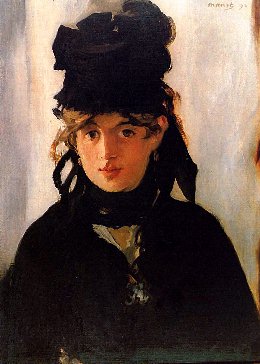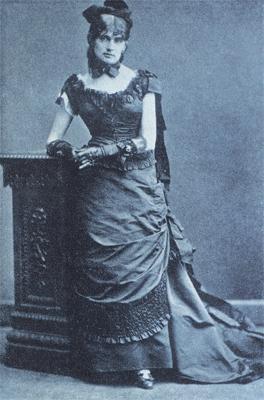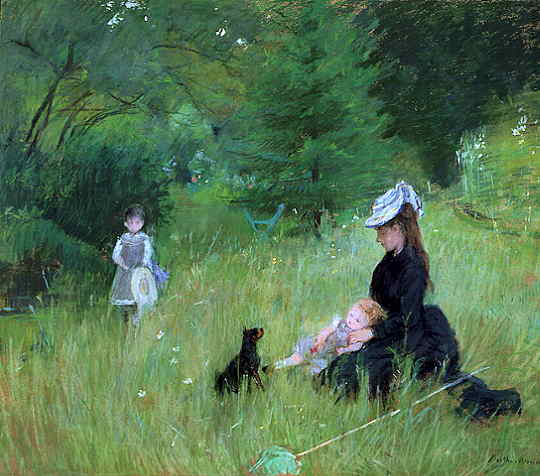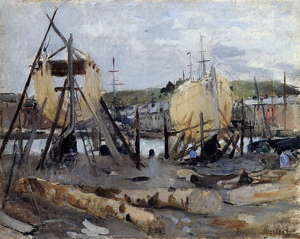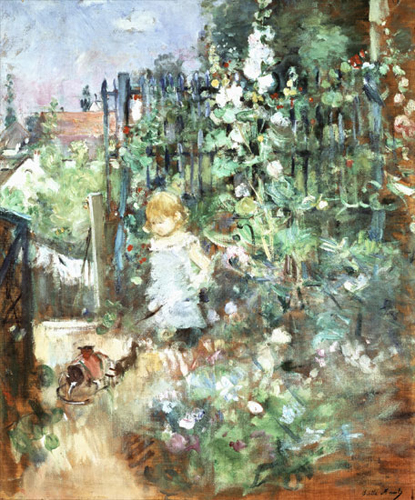| Berthe Morisot
The Art History Archive - French Impressionism
Berthe Morisot (January 14, 1841 – March 2, 1895) was a French Impressionist painter. Born in Bourges, Cher, France into a successful bourgeois family who encouraged her and her sister Edma Morisot in their exploration of art, she demonstrated the possibilities for women artists in avant-garde art movements at the end of the 19th century. Once Morisot settled on pursuing art, her family did not impede her career. By age 20, she met and befriended the important landscape painter of the Barbizon school, Camille Corot, who introduced her to other artists and teachers. She took up plein air techniques and painted small pieces outdoors either as finished works or as studies for larger works completed in the studio. Morisot's first acceptance in the Salon de Paris came in 1864 with two landscape paintings, and she continued to show regularly in the Salon until 1874, the year of the first impressionist exhibition. She was acquainted with Edouard Manet from 1868, and in 1874 she married Eugene Manet, Edouard's younger brother. She convinced Manet to attempt plein air painting, and drew him into the circle of acquaintance of the painters who became known as the impressionists. However, he never considered himself an impressionist or agreed to show with the group.
Morisot, along with Camille Pissarro, was one of only two artists whose work exhibited in all of the original impressionist shows. Like Mary Cassatt, during her lifetime, Berthe Morisot was relegated to the category of "feminine" artists because of their usual subject matter — women, children, and domestic scenes. However, as a doctrinaire impressionist, Morisot painted what she saw in her immediate, everyday life. As a woman securely in the "haute bourgeoisie" she saw domestic interiors, holiday spots, other women, and children. Without exception, her subject matter shows the equivalent of that of her impressionist colleagues. Edgar Degas, the dandy male bourgeois, painted rehearsals of the ballet, horse races, and nude women in apartments (rather than studios). Claude Monet painted his garden, his children, and his neighbor's haystacks. Female impressionists painted their social milieu in a way consistent with the impressionist approach to subject matter. Berthe Morisot died in Paris and was interred in the Cimetière de Passy. Today, her paintings can sell for more than $4 million.
Paintings by Berthe Morisot
Quotes by Berthe Morisot A love of nature is a consolation against failure. I wear myself out trying to render the orange trees so that they're not stiff but like those I saw by Botticelli in Florence. It's a dream that won't come true. It is important to express oneself... provided the feelings are real and are taken from your own experience. Real painters understand with a brush in their hand. There I found Manet, with his hat on in bright sunlight, looking dazed. He begged me to go and see his painting, as he did not dare to move a step. More Info: Though her first submissions to the Salon in 1864 had been well received, and she continued to exhibit there until 1873, she stopped sending work after the 1874 Nader studio exhibition, preferring thenceforth to show with the Impressionists. In 1874 she showed four oils, three pastels, and two watercolors and her works received a few amiable comments; two years later she showed another thirteen oils. By 1876 the critics had noted the emergence of a distinct “impressionist” style, and Morisot’s wholehearted embrace of its forms was not received universally well. Arthur Baignères wrote: “she pushes the system to its extreme, and we feel all the more sorry about this as she has rare talent as a colorist,” while another critic considered that “she particularly is the victim of the system of painting that she adopted.” It was around this time she began focusing on painting out of doors; light became the most important aspect of her pictures as darting brushwork replaced her earlier more conventional style. Morisot’s favorite subject, her daughter Julie, was born four years after her marriage to Eugène. Unlike her sister, Morisot balanced her role of wife and mother with that of artist, continuing to paint, something she had thought earlier to be an impossibility; she had assumed she would have to sacrifice marriage and motherhood for her art. The Manet family lived quietly, preparing for Impressionist shows, traveling (trips to Italy in 1881 and 1882 immensely affected her landscapes) and entertaining their artist friends who including Renoir, Degas and Whistler. The 1890’s saw another change in Morisot’s style, outline returned to her painting and stronger forms lent weight to the compositions. She withdrew somewhat with the death of her husband in 1892, preparing for her first solo show and spending time with her daughter and nieces. Morisot died in 1895, catching influenza while nursing her ill daughter. The sentimentality and sweetness sometimes found in Morisot’s figure paintings, harkening back at times to Fragonard and the 18th century painters, seemed at odds with all descriptions of her personality, suggesting that she painted a peaceful world she sought, not experienced. Her subjects were serene, images of mothers and children, young girls, seascapes, and views of town and country, but she was just the opposite: ambitious, stern and characterized by her husband as having “only an empty shell of a heart.” Her painting was a brave and hopeful face of happiness that masked the despair and insecurity that haunted her throughout her entire life. Morisot was highly self-critical and demanding, yet she was a loving mother and inspired passionate friendships with her contemporaries Degas, Monet, Renoir, Puvis de Chavannes, Mallarmé and the young Henri de Règnier, her presence seeming to calm their quarrels.
Morisot's first appearance in the Salon de Paris came at the age of twenty-three in 1864, with the acceptance of two landscape paintings. She continued to show regularly in the Salon until 1874, the year of the first impressionist exhibition. Meanwhile, in 1868 Morisot became acquainted with Édouard Manet. He took a special interest in Morisot, as is evident from his warm portrayal of her in several paintings. One includes a striking portrait study of Morisot in a black veil, while in mourning for her father's death. It is displayed at the top of the article. Correspondence between them bespeaks affection. He once gave her an easel as a Christmas present. He also interfered in one of her Salon submissions when he was engaged to transport it. Manet mistook one of Morisot's simple self-criticisms, as an invitation to add his corrections, which he did, much to Morisot's dismay. Although traditionally Manet has been related as the master and Morisot as the follower, there is evidence that their relationship was a reciprocating one. Morisot had developed her own distinctive artistic style. Records of paintings show Manet's approval and appreciation of certain stylistic and compositional decisions that Morisot originated. He incorporated some of these characteristics into his own work. It was Morisot who convinced Manet to attempt plein air painting, which she had been practicing since having been introduced to it by Corot. She also drew Manet into the circle of painters who soon became known as, the Impressionists. In 1874, Morisot married Manet's brother, Eugene, and they had one daughter, Julie. As a doctrinaire impressionist as well as a member of the haute bourgeoisie, Morisot painted what she experienced on a daily basis. Her paintings reflect the 19th century cultural restrictions of her class and gender. She avoided urban and street scenes as well as the nude figure and, like her fellow female impressionist Mary Cassatt, focused on domestic life and portraits in which she could use family and personal friends as models. Paintings like The Cradle, 1872 in which she depicted current trends for nursery furniture reflect her sensitivity to fashion and advertising, both of which would have been apparent to her female audience.
|
|
